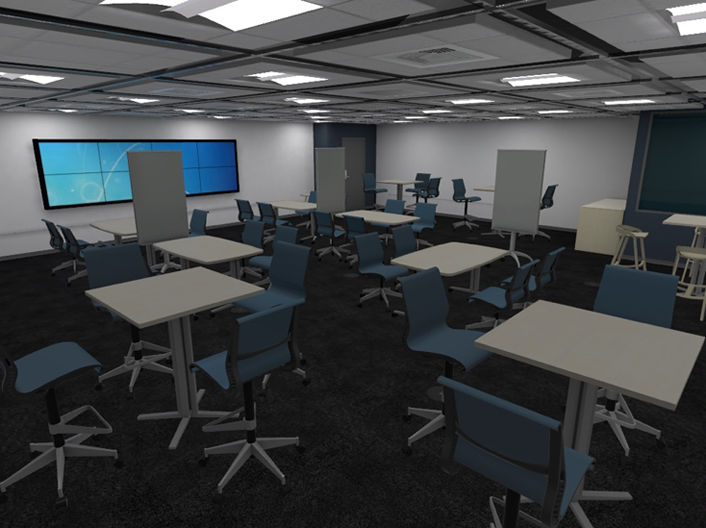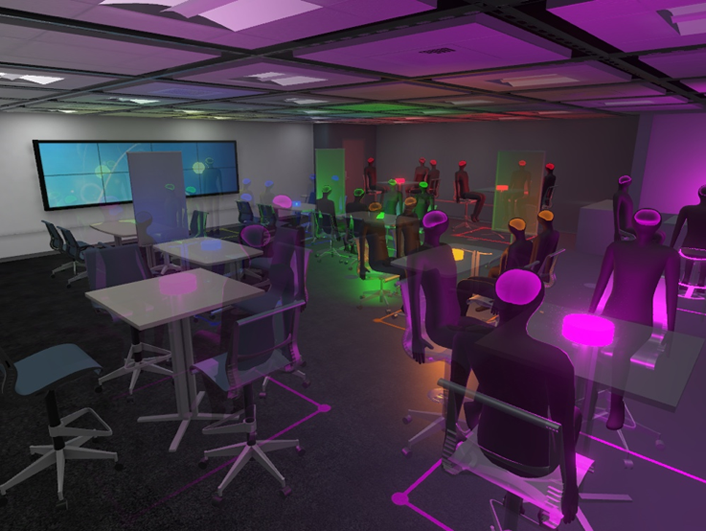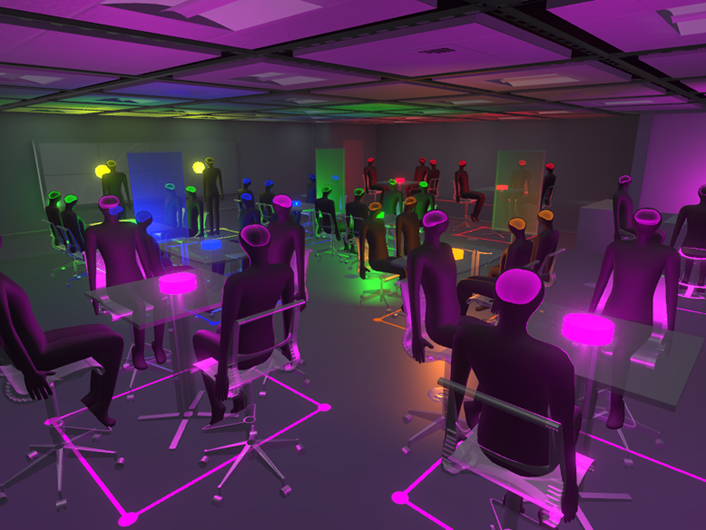The process of helping instructors understand how best to teach in active learning classrooms should itself model the principles of teaching in those spaces.

Individuals across higher education—administrators, faculty, architects, and others—increasingly recognize that physical classroom spaces need to be designed to better accommodate active learning. This means making classrooms more flexible in all aspects, including furniture, ways of sharing content, writing surfaces, and power sources. At Penn State, we believe that the professional development we design to support faculty in these spaces must be flexible as well.
For some faculty, this means finally having a space where they can engage students in the kinds of learning activities they've dreamed about or that they've attempted in more constrained traditional spaces. Others find themselves in flexible spaces and report wishing they'd had more notice to better prepare their instruction. Still others find themselves in newly designed rooms, differently appointed from those in which they're accustomed to teaching, unsure as to what to do.
In rethinking physical classroom spaces, scholars have long recommended that considerations include human-centered design, principles of learning, and diverse learning-focused technologies. More recently, the Learning Space Rating System is built on seven principles of learning space design, which describe the extent to which a given space promotes active learning.
As faculty development evolves to support instructors who teach in flexible learning spaces, we propose a design philosophy with three tenets that encompass both learning spaces and faculty development:
- Aim: What is provided should be designed and allocated equitably rather than equally.
- Extent: When scaling, there should be as much inherent flexibility as resources will allow.
- Agency: Faculty should be given spaces and support such that there is well-placed confidence in their professional decision-making around classrooms and pedagogy.
Flexible Learning Spaces
In our model, the three tenets would be applied any time a physical space is designed (or redesigned) to support active learning.
Aim
Classroom designs should aim to provide flexible learning environments for all who teach and learn in them. Representing a wide range of contexts and resources, hundreds of colleges and universities are increasingly attending to this important goal when designing or renovating classroom spaces for active learning. A quick search of FLEXSpace, for example, reveals thousands of classroom designs from around the world. Many flexible space designs can accommodate a rich—and necessary—variety of teaching approaches.
Importantly, this design tenet stresses that there should be flexibility within the institution, with the aim of equitable spaces for all. This is not a new idea, of course; we simply stress that "equitable" here shouldn't be confused with "equal." The term "equal" suggests that all rooms at an institution are similarly appointed. Ideally, room design should be variable across campus in order to be matched to different pedagogical goals and appropriate instructional approaches. Again, current trends are moving in this direction.
Extent
We need to create lots of flexible spaces. Admittedly, many factors can limit the extent of such spaces—limitations could pertain to the total number of active learning spaces at an institution or the degree of flexibility within any individual classroom. For example, purchasing equipment in bulk is cheaper than buying piecemeal, but "bulk buy" has trade-offs—the rollout of "updated" spaces could end up being merely operational, with every space receiving the same setup. Unfortunately, privileging lower costs over teaching and learning considerations is problematic. To the extent possible, we should avoid it.
Agency
Under the typical nature and chronology of classroom design, (1) classroom spaces get designed without much faculty input, and (2) instructors are assigned to those classrooms and must live with what they get. The good news is that this is changing. Leading the charge have been institutional efforts, such as Indiana University's MOSAIC Initiative, where Learning Space Fellows are empowered to be agents of change.
Now that flexible spaces are in vogue, what kind of faculty development is most appropriate to support those who teach in them? If we were to evaluate the current landscape of faculty development, we would find a range of developed programs that engage faculty in highly structured ways, or we might find opportunities for faculty to consult with an instructional designer or a consultant about a particular course challenge. Several questions arise, however, about these kinds of programs:
- How valuable is highly structured faculty development?
- How scalable are individual consultations, given limited personnel resources?
- Are these approaches appropriately flexible to meet faculty members' needs around flexible learning spaces?
Contextualized Faculty Development
Applying the same tenets to faculty development as to learning space design facilitates a richer understanding for instructors who will use those spaces.
Aim
As with learning spaces, faculty development should also be flexible. All faculty, regardless of discipline, content, or context, should find value in a range of experiences and opportunities. Again, the aim is support that is equitable rather than equal. Faculty development for flexible learning spaces can't be a one-size-fits-all model, which would fulfill the needs of some but not others. Yet, determining the scope of faculty needs requires some effort.
We might administer an evaluation at the end of a current engagement, or we might conduct an institutional needs assessment. We should also consider evidence-based practices based on how people learn, practical time demands on faculty schedules, shifts in course requirements, and optimal timing for when faculty development offerings should occur. Can we really balance all of these concerns, geared toward the aim of flexible faculty development, while building a robust toolbox of skills for faculty teaching in flexible spaces? Perhaps.
Extent
One way to create a suite of faculty development opportunities for flexible classrooms is to layer and diversify those opportunities so they can be both actionable and proactive, as well as "just in time"—in other words, flexible, like the spaces themselves.
- Traditional approaches such as workshops and institutes are helpful when there is time to plan and apply the content to flexible learning spaces.
- Rich repositories of online resources, such as those available at Vanderbilt, serve both advance-planning and just-in-time needs, especially for faculty who prefer to design engaging student activities from the comfort of their home office. Such resources often provide relevant examples and support for timely implementation.
- Faculty facilitators (some call them faculty champions) allow us to leverage the experiences of faculty who are pushing the limits of the space affordances to fully engage students in the learning process and share the creative thinking of those instructors with others.
- Many institutions foster Faculty Learning Communities as another type of flexible learning opportunity available to faculty who may want peer-to-peer engagement.
At Teaching and Learning with Technology at Penn State, we are experimenting with a virtual space where faculty can imagine and consider the implications of instructional ideas before trying them in a physical classroom. The design of this virtual space was inspired by a flexible classroom on our campus, which was recreated in the game development platform Unity (see figure 1).

In this space, using a VR headset in a game-like atmosphere, faculty can think critically about the activity strands that are happening with their students, the space affordances, the number of students in the flexible learning space, and types of active learning experiences they want to create (see figures 2 and 3). Here, instructors can explore the implications of different engagement strategies, classroom management challenges, and transitions between activities.


The intent is to use the Oculus Go, in conjunction with an online course, as the medium to share this faculty development experience. This can be a scalable option for geographically distributed institutions, such as ours, as well as a means for connecting those faculty who may not want a face-to-face, highly structured program.
Agency
What if faculty, regardless of discipline, were savvy, agile, and confident in a way that, regardless of the room they are assigned, they are equipped with the knowledge and skills to create just the right configurations and to deploy the best pedagogical approaches? What if, when it's time to request space, faculty are empowered to ask for classrooms that match their pedagogical needs rather than rooms that can simply seat the right number of students? We see an interesting irony at play here: as faculty are supported in becoming more pedagogically agile, they will be able to think strategically about how to achieve their pedagogical goals in any space. But because knowledge is power, we suspect they will grow increasingly weary of spaces that are inflexible and, hopefully, begin to clamor for what they and their students really need.
To achieve this, a one-size-fits-all approach to faculty development for flexible learning spaces will fall short. Instead, supporting faculty to grow their arsenal of appropriate tactics—ones that fit their students' learning needs—can be the first step. Flexible faculty development, with opportunities for instructors to stretch their "pedagogical muscle" with others thinking in the same place, is critical as well. We believe in a knowledgeable and empowered faculty, one that inspires a collective confidence built upon a flow of creative ideas and a full toolbox of skills. Designing our faculty development opportunities to be as flexible as the spaces themselves is an important step.
Crystal Ramsay is Research Project Manager of Faculty Programs at Penn State University.
Angela Dick is Manager of Learning Design at Penn State University.
© 2019 Crystal Ramsay and Angela Dick. The text of this work is licensed under a Creative Commons BY 4.0 International License.
